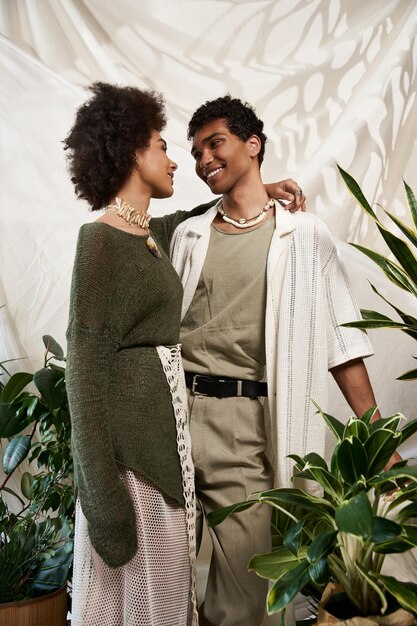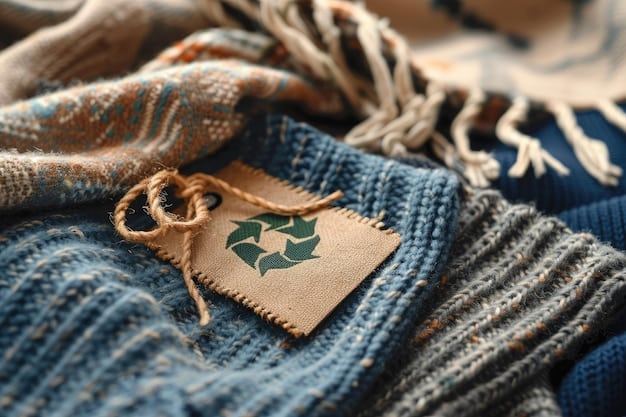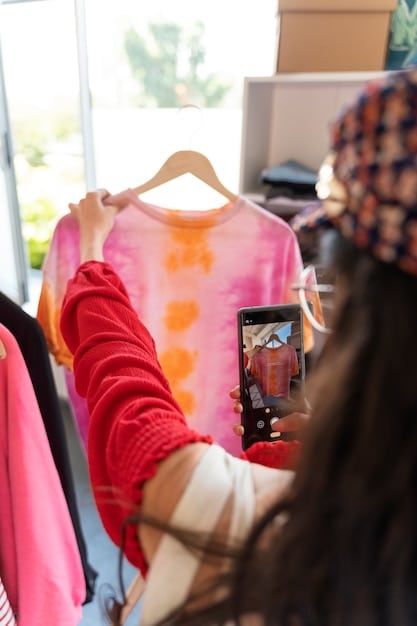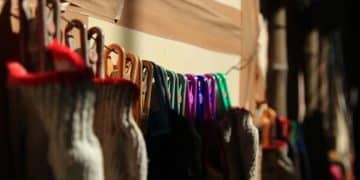The 2025 Guide to Affordable Sustainable Fashion Brands in the US

The 2025 Guide to Affordable Sustainable Fashion Brands in the US highlights brands committed to ethical practices, eco-friendly materials, and fair labor, offering consumers stylish and budget-friendly options without compromising on sustainability.
Navigating the world of fashion with both your wallet and the planet in mind can feel overwhelming. But what if you could find stylish and ethical clothing that doesn’t break the bank? This is your definitive 2025 Guide to Affordable Sustainable Fashion Brands in the US, showcasing companies that are leading the way in eco-conscious and budget-friendly fashion.
Why Sustainable Fashion Matters
Before diving into the list of brands, it’s essential to understand why sustainable fashion is so crucial. The fashion industry is a significant contributor to environmental pollution, from water contamination caused by textile dyeing to the carbon emissions from manufacturing and transportation. Choosing sustainable brands helps reduce your environmental footprint and supports ethical labor practices.
Environmental Impact of Fast Fashion
Fast fashion’s business model revolves around producing trendy, inexpensive clothing at a rapid pace. This leads to overconsumption, textile waste, and harmful production processes. The use of synthetic materials like polyester, which is derived from petroleum, further exacerbates the problem.
Ethical Considerations in Fashion
Beyond environmental concerns, ethical issues are also prevalent in the fashion industry. Many fast fashion brands rely on cheap labor, often in unsafe working conditions, to keep costs down. Sustainable brands prioritize fair wages, safe workplaces, and the well-being of their workers.
- Reduce your carbon footprint by choosing eco-friendly materials.
- Support fair labor practices and safe working conditions.
- Minimize textile waste by investing in durable, long-lasting clothing.
- Contribute to a more circular economy where resources are reused and recycled.
By making informed choices and supporting sustainable brands, you can positively impact the environment and the lives of garment workers. Sustainable fashion is not just a trend; it’s a necessary shift towards a more responsible and equitable industry.

Key Features of Affordable Sustainable Brands
What sets affordable sustainable fashion brands apart from the rest? Several key features define their commitment to ethical and environmental responsibility. These criteria can help you identify brands that align with your values and budget.
Eco-Friendly Materials
Sustainable brands prioritize the use of eco-friendly materials such as organic cotton, recycled polyester, Tencel, and linen. These materials have a lower environmental impact compared to conventional fabrics. Organic cotton, for example, is grown without synthetic pesticides and fertilizers, reducing water pollution and protecting biodiversity.
Ethical Production Practices
Ethical production practices ensure fair wages, safe working conditions, and respect for workers’ rights. Brands that prioritize ethical production often partner with factories that are certified by organizations like Fair Trade or WRAP (Worldwide Responsible Accredited Production).
- Transparency in supply chain: Knowing where and how your clothes are made.
- Use of recycled and upcycled materials to reduce waste.
- Commitment to reducing water and energy consumption in production.
- Implementation of circular economy principles, such as take-back programs.
These features ensure that the brands are not only environmentally responsible but also socially conscious. By understanding these key aspects, you can make informed decisions and support brands that truly make a difference.
Top Affordable Sustainable Fashion Brands in the US for 2025
Now, let’s explore some of the top affordable sustainable fashion brands in the US that are making a positive impact. These brands offer a range of stylish and eco-friendly clothing options without compromising on quality or affordability.
Patagonia
Patagonia is a well-known brand committed to environmental activism and sustainable practices. They offer a wide range of outdoor clothing and gear made from recycled materials and organic cotton. Their Worn Wear program encourages customers to repair and recycle their Patagonia products, extending the life cycle of their clothing.
ABLE
ABLE is a fashion brand focused on empowering women by providing economic opportunities. They produce their clothing and accessories in Ethiopia and Mexico, ensuring fair wages and safe working conditions for their employees. ABLE also publishes their wages, promoting transparency and accountability.
- Everlane: Known for its radical transparency and commitment to ethical factories.
- People Tree: A pioneer in fair trade fashion, offering organic cotton clothing and accessories.
- United By Blue: For every product sold, United By Blue removes one pound of trash from oceans and waterways.
These brands demonstrate that sustainable fashion can be both stylish and accessible. By supporting these companies, you can contribute to a more ethical and environmentally responsible fashion industry.

Tips for Building a Sustainable Wardrobe on a Budget
Creating a sustainable wardrobe doesn’t have to be expensive. With a few smart shopping habits and creative strategies, you can build a collection of eco-friendly clothing without breaking the bank. Here are some tips to help you get started:
Shop Secondhand
Thrift stores, consignment shops, and online marketplaces are great resources for finding affordable and unique clothing. Secondhand shopping reduces textile waste and gives garments a new life. Platforms like ThredUp and Poshmark offer a wide selection of gently used and vintage clothing.
Invest in Versatile Pieces
Focus on buying versatile pieces that can be mixed and matched to create multiple outfits. A few well-chosen basics can go a long way in building a sustainable wardrobe. Opt for classic styles and neutral colors that can be easily paired with different pieces.
- Choose quality over quantity: Invest in durable, well-made pieces that will last longer.
- Rent clothing for special occasions: Consider renting outfits instead of buying new ones for events.
- Host clothing swaps with friends: Organize a clothing swap to exchange unwanted items and refresh your wardrobe.
By adopting these strategies, you can create a sustainable and stylish wardrobe without overspending. Remember, every small action counts towards a more environmentally friendly and ethical fashion industry.
The Future of Affordable Sustainable Fashion
The future of affordable sustainable fashion looks promising, with increasing consumer demand and technological advancements driving innovation and accessibility. As more brands embrace sustainable practices and consumers become more conscious of their purchasing decisions, the industry is poised for significant transformation.
Technological Innovations
Technological advancements are playing a crucial role in making sustainable fashion more affordable and efficient. Innovations in textile recycling, waterless dyeing, and 3D printing are reducing the environmental impact of clothing production and lowering costs.
Increased Consumer Awareness
Consumers are becoming more aware of the environmental and ethical issues associated with fast fashion. This increased awareness is driving demand for sustainable alternatives and encouraging brands to adopt transparent and responsible practices. Social media and online platforms are playing a key role in educating consumers and promoting sustainable brands.
- Growing collaboration between brands and environmental organizations.
- More government regulations and incentives to promote sustainable practices.
- Increased investment in research and development of sustainable materials.
- Greater emphasis on circular economy models and waste reduction.
These trends indicate a positive trajectory for the future of affordable sustainable fashion. As the industry continues to evolve, consumers will have more options to choose from and can make a greater impact on the environment and society.
How to Spot Greenwashing in Fashion
As sustainable fashion becomes more popular, some brands may engage in “greenwashing,” presenting themselves as more environmentally friendly than they actually are. It’s essential to be able to identify greenwashing to make informed purchasing decisions.
Vague Language and Empty Claims
Be wary of brands that use vague language like “eco-friendly” or “natural” without providing specific details about their sustainable practices. Empty claims without supporting evidence are a red flag that a brand may be greenwashing.
Lack of Transparency
Transparency is crucial in sustainable fashion. Brands that are truly committed to sustainability should be open about their supply chain, production processes, and environmental impact. If a brand is unwilling to share this information, it’s likely they are not as sustainable as they claim.
- Look for certifications from reputable organizations like GOTS (Global Organic Textile Standard) and Fair Trade.
- Check for detailed information about materials, manufacturing processes, and labor practices.
- Research the brand’s environmental and social initiatives and look for evidence of their impact.
- Be skeptical of marketing campaigns that focus solely on environmental benefits without addressing ethical issues.
By being aware of these tactics and doing your research, you can avoid falling victim to greenwashing and support brands that are genuinely committed to sustainability.
| Key Point | Brief Description |
|---|---|
| 🌱 Eco-Friendly Materials | Using organic, recycled, or innovative materials to reduce enviromental impact. |
| 🤝 Ethical Production | Ensuring fair wages, safe conditions, and worker empowerment in factories. |
| ♻️ Secondhand Shopping | Extending the life cycle of garments through thrift stores and online marketplaces. |
| 🌿 Greenwashing Awareness | Being cautious of vague claims and lack of transparency from so-called “eco-friendly” brands. |
Frequently Asked Questions (FAQ)
▼
A sustainable fashion brand prioritizes eco-friendly materials like organic cotton and recycled polyester, ethical production practices ensuring fair wages, and transparency in its supply chain.
▼
Look for brands that offer versatile pieces, participate in secondhand markets, and employ innovative technologies to reduce costs and environmental impact.
▼
Common eco-friendly materials include organic cotton, recycled polyester derived from plastic bottles, Tencel made from sustainably sourced wood pulp, and linen, which requires less water to grow.
▼
Avoid brands with vague language and empty claims. Look for certifications like GOTS, check for supply chain transparency, and research the brand’s actual environmental and social initiatives.
▼
Sustainable fashion reduces the environmental impact of the fashion industry, promotes ethical labor practices, and encourages a circular economy by minimizing waste and reusing resources.
Conclusion
As we look ahead to 2025, the landscape of affordable sustainable fashion is evolving rapidly. By choosing affordable sustainable fashion brands in the US, adopting smart shopping habits, and staying informed about greenwashing tactics, you can make a positive impact on both the environment and the lives of garment workers. Embrace the journey towards a more sustainable and stylish future.





